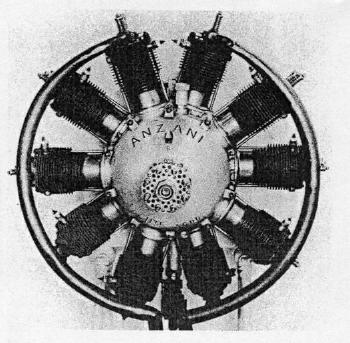
Anzani 10-cylinder 100 hp engine (1913)
Motorcycle builder Alessandro Anzani of Courbevoie in France sprang into eminence in 1909 with one of his first aero engines, a 3-cylinder W or fan type with crude air cooling and make-and-break ignition. This configuration has three cylinders arranged in a V with an extra cylinder vertically upright in the center. It had a 105 mm bore and a 130 mm stroke giving a capacity of 3.75 litres and produced 24 hp at 1,600 rpm for a bare weight of 66 kg including a 26-kg flywheel. Provided it did not overheat it was fairly reliable. One took Bleriot to Dover on 25 July 1909. From April 1909 Anzani also sold the engine with 120 x 130 mm cylinders of 35 hp and 135 x 150 mm cylinders of 45 hp. By December 1909 he was running a 3-cylinder radial with 120 degrees between the cylinders. About three months later he had created the first 2-row radial by adding a second 120-degree 3-cylinder row behind the first, rotated 60 degrees to give all cylinders equal cooling. He retained sprung automatic inlet valves, and decided to use a kinked crank-web to bring the front and rear cylinders closer together by using very slim but broad connecting rods and more refined slipper-type big ends. Using slightly smaller 90 x 120 mm cylinders, the first of these 6-cylinder radials was advertised as giving 45 hp at 1,300 rpm.
By late 1913 Anzani had no fewer than seven types of aero engine on sale. At this stage all his engines were hand-built in ones and twos. Biggest were the 10-cylinder radials, one of the 110-hp size with 105 x 140 mm cylinders being exhaustively tested at Farnborough in 1914. Anzani production in World War I was mainly for trainers, but before the end of that conflict he had introduced push-rod operated inlet valves with the exhaust valves directly ahead of the inlets. There followed a further profusion of different types, some with water cooling, but none received the concentrated effort needed for high reliability. Small numbers continued to find buyers, among them Clyde Cessna whose first aircraft had the 120-hp 10-cylinder Anzani engine. In 1928 Potez used Anzani cylinders in the first of his 6-cylinder single-row radials.
 |
|
Anzani 10-cylinder 100 hp engine (1913) |
The most powerful of the commoner pre-war Anzanis was the 10-cylinder of 1913, rated at 100 hp. It is not immediately obvious that the cylinders are in front and rear rows. The carburettor is at the bottom. To reduce plug oiling the spark plugs were inserted on the upper sides of the cylinders.